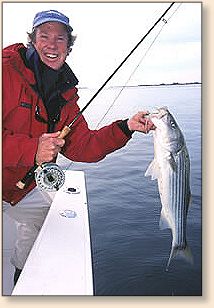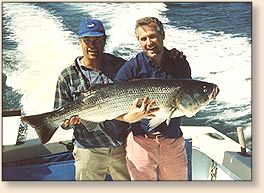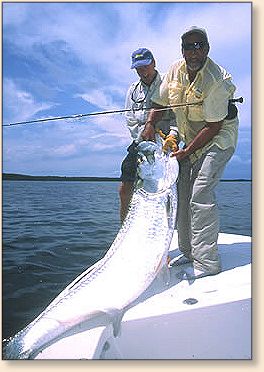
To the ardent saltwater flyfisher, flats fishing
embodies the ultimate fly-rodding challenge. As Capt.
Paul Dixon observes, flats fishing gives you a unique
window into the fish's world. Since the clear shallow
water allows you to see the fish, you can note how a
fish reacts to different flies and manner of your fly
presentation. You assume the posture of a hunter
stalking your elusive prey, as you watch a striper
or bonefish swim near your boat and then try to get
him to grab your fly.
From the Florida Keys to the tip of Cape Cod, the
Eastern Seaboard presents ample opportunities for
a sensational day poling or wading the flats. As
more Northeasterners discover the allure of fishing
the flats, New England stripers are becoming almost
as sophisticated and finicky as the bonefish, tarpon
and permit found in the Florida Keys.
If you think that trophy catches can only be found
offshore while deep sea fishing, Capt. Rich Benson
has spotted some 50-pound stripers on the Monomoy
flats and Capt. Paul Dixon has seen 40-pound stripers
in Gardiner's Bay. Also, Capt. Tom Mleczko caught a
47-pound cow while wading the Nantucket flats and
Florida Keys guide Capt. Dexter Simmons landed a
160-pound tarpon aboard his skiff "Flatsmaster."

Even though the geography and species of fish vary
widely as a saltwater fly fisher poles and wades from
the Keys to the Cape, the basic techniques of flats
fishing remain the same. Casting accuracy and line
control are the two most important techniques needed
to fish the flats.
In order for a fly fisher to have a shot at landing
the Florida Key's "big three" (tarpon, bonefish, and
permit), Capt. Dexter Simmons recommends that prospective
flats fishers should lean how to double haul the fly
line. Mastery of this technique can enable you to make
accurate long casts in windy conditions with rods ranging
from 8 to 12-wt. While fly fishers desiring to fish the
Floridian flats should aim for casting distances of 80 feet,
a fish can be caught in the Keys with a shorter although
very accurate cast.
As a general rule of thumb, fly fishers who can double
haul and deliver an accurate 40 to 50 foot cast will
have prime opportunities to catch fish. While some
guides offer casting instruction, others prefer to
focus on finding fish for their clients. So, if you
want some casting pointers or a day of casting
instruction with some flats guiding, be sure to
ask the guide if he provides casting advice before
stepping onto the boat.
Flats guides tell their clients where the fish are
located by using the clock method. Imagine the bow
of the flats skiff to be at 12 o'clock with the guide
standing or poling behind you at 6 o'clock. So, when
a guide calls out, "Fish 50 feet at 1:00 o'clock,"
that means you need to cast your line quickly 50 feet
to your right front. If your guide spots a fish at
12 o'clock, give him a little time to poll the boat
to one side. Otherwise, when you cast back, you have
a very good shot at hooking your guide instead of a
fish.
If Capt. Rich Benson has a right handed angler on
the bow and the fish is at that imaginary one o'clock
position, he'll tell the fly fisher to wait until he
pushes the stern around until the fish is at the ideal
eleven o'clock spot. He finds that nine to eleven o'clock
is the best cast for a righty and one to three is the
best for a lefty.
If you are uncertain regarding exactly where you should
cast, point your rod in the direction you think you
should cast. The guide can then tell you to cast
slightly to the left or right. Unless the guide
tells you to "cast right now," try to refrain from
casting until you can see the fish. Casting where
you "think" the fish might be will probably result
in a bad cast. Also, you run the risk of spooking
the fish or in the worst-case scenario, actually
hitting the fish on the head with the fly.
 While a guide can direct you to a moving fish, you
need to be able to place your fly line quickly and
accurately in order to land a fish. Ideally,
prospective flats fishers should be able to shoot
the fly line without having the line tangle or fall
in a pile at your feet. As Capt. Rich Benson notes,
this is finesse fishing, so don't do the waltz while
you're casting and have your line going all over the
place.
While a guide can direct you to a moving fish, you
need to be able to place your fly line quickly and
accurately in order to land a fish. Ideally,
prospective flats fishers should be able to shoot
the fly line without having the line tangle or fall
in a pile at your feet. As Capt. Rich Benson notes,
this is finesse fishing, so don't do the waltz while
you're casting and have your line going all over the
place.
Another common mistake made by fly fishers is standing
on the line or leaving the retrieved line in a tangled
pile on the casting platform. While many tropical
fly fishers fishing from a boat don't use a striping
basket, Capt. Tom Mleczko is working on developing
a stationary striping basket for use on his flats
boat. Also, be sure to pull out only the line you
will need. Too many fly fishers approach the casting
platform and then pull off 60 feet or more of fly line,
when they will only need to cast 40 feet.
Saltwater fly fishers use to hauling a clouser into
the surf with a resounding splash need to refine
their cast, so that they can position the fly with
precision and accuracy without making so much noise
that the fish spooks and runs. Conversely, freshwater
anglers often try to make a quiet delicate presentation,
as though they were fishing for that elusive trout
using a #20 blue winged olive rather than stalking
a fast moving striper with a 2/0 chartreuse clouser.
Many flyfishers unaccustomed to fishing the flats
tend to make too many false casts. Capt. Tom Mleczko
recommends one false cast or a double haul and then
a quick presentation to the fish or else your prey
will be gone by the time your fly hits the water.
Simply put, the more times you can put the fly on
target, the more hookups you'll enjoy during your
trip. Bear in mind that a windy day on the flats
can provide for a challenging day of fly fishing
for even the most experienced saltwater fly rodder.
While bass remains the predominant species on the
Northeast flats, one can encounter the occasional
bluefish. When you hook a fish and notice that when
your fly has been bitten clean off, that's a strong
sign that you're battling a blue. So, it's time to
switch to a shock leader tippet (12" maximum) of
monofilament leader or heavy wire to keep from
losing any more flies.
The decision between using monofilament or wire boils
down to individual preference. Some guides prefer
using clear 60 to 80 lb. monofilament out of concern
that a wire tippet is visible on the flats and will
spook a wary fish. Rich Benson find that he is able
to land blues on the flats using 27lb Malin stainless,
coffee colored piano wire, tied with haywire twists,
and then Albrighted from the tippet to the wire. Also,
he makes up about two-dozen "clunker flies" that he
doesn't care about anymore. On these flies, he uses
Berkley Sevenstrand wire and crimps the wire to the
fly and then crimps another loop to tie to the tippet.
When retrieving the fly, keep the rod tip well above
the water and pointed directly at the fish. You should
manipulate the fly by striping in the line and refrain
from using the rod tip to tease the fly. Capt. Rich
Benson finds that a fast retrieve in two to three
spurts really attracts the Northeastern stripers.
He cautions not to stop the fly, as this will cause
the bass to turn away. When using crab patterns, he
says, "Go slow." According to Capt. Rich Benson,
fishing for Northeastern bass is probably the best
way to learn how to fish for the elusive permit.
Capt. Paul Dixon recommends getting your fly down
to the fish's level. Keep your line tight, so the
fly moves when you want it to and it's not making
unnatural random moves. Also, since you can actually
see the fish, you should try to read the fish's body
language. Once you learn how a given species responds
to different flies, your success rate will increase.
One critical factor in flats fishing is the need for
light. A full day flats trip tends to go from
approximately 8am to 4pm. The optimal time for most
folks to fish the flats is from 10am-2pm, when the
sun is at its brightest. Polarized glasses are a
necessity for spotting fish on the flats. Also, a
hat with a dark under brim will help reduce glare.
Another crucial weather factor is the seasonal tides.
Keeping track of the moon phases and how they
influence the tides is integral in flats fishing.
A new or full moon tends to bring the spring tides,
which are stronger and tend to produce the best
fishing. Flats fish tend to feed and move from
deeper to shallow water depending on the tidal
cycles, with each flat having its own distinctive
characteristics.

Flyfishers are noted for their gadgets and most
flats guides make sure their boats are equipped
with a Boga Grip scale that's certified by the
IGFA for world record catches. This device is
ideal for catch and release fishing, as the fish
may be weighed by the official scale and then
released unharmed. Other favorite tools include
a pair of nippers and a Gerber Multi tool.
While the majority of flats fishing tends to be
done from a flats boat, certain flats are accessible
by wading. Awareness of your surroundings is key
in wading the flats to ensure your safety and enable
you to catch fish. In particular, be mindful of the
rising tide, as leaving the flat and returning to
shore can become difficult once the flat is no
longer visible.
When wading the flats, look for bait jumping out
of the water. If you don't see anything breaking
on the water, look in the deeper water for darker
areas. Often, these spots are fish or bait.
The cold Northeast waters dictate that most fly
fishers wear waders with flats boots especially
when fishing at daybreak. When fishing in more
tropical waters, some fly fishers have found that
the more inexpensive dive booties work just as well
as flats boots for wet wading, depending on the bottom
and sea life such as spiny anemone or rays. A
stripping basket comes in handy to keeps your line
clean and tangle free, a must on those windy days.
While some fly fishers like using mesh basket,
other prefer the hard plastic tubs.
If you've never fly fished before, Capt. Tom Mleczko
recommends booking three half-day trips. On the first
day, you'll receive casting instruction and then wade
the ponds of Nantucket. The second day will be a trip
on a fishing boat blind casting for bluefish and stripers.
On the third day, you'll move to sighting and casting
to striped bass from the flats skiff.
Keep in mind that the recent explosion of flats fishing
has led to the proliferation of flats guides. The more
experienced flats guides are happy to tell you about
their background and can describe in detail their boat
and the fly-fishing gear that they use for flats fishing.
The local fly shops tend to be excellent resources for
recommending qualified guides.
Finally, remember that this sport is called "flats fishing"
not "flats catching." A flats guide can guarantee you'll
see fish, while poling or wading through a breathtaking
location. However, whether or not you land a fish depends
on both your casting skill and how well the fish are feeding.
As Capt. Tom Mleczko states, he's taken out novice fly
rodders, who landed a striper during a blitz, while some
days even his most experienced saltwater fly fishers get
skunked. Capt. Dexter Simmons observes that if you are
prepared skill wise and make the most of every shot you
are given at fish during your trip, then your odds of
a having a successful flats fishing experience will
be greatly enhanced. ~ Becky Garrison
GUIDES FEATURED IN THIS ARTICLE
RICH BENSON
AREA GUIDES: Monomoy Island, Chatham, Cape Cod, MA
PREFERRED SETUP: 9-wt fly rod with a 10-wt intermediate
or floating line and the best reel you can afford.
BOAT DESCRIPTION: 2000 Hewes LT 18
FAVORITE FLIES: clousers, deceivers, squid flies, sand eels, Tom's Rattle Crab.
CONTACT INFORMATION: 508-432-6264; stripercity@aol.com
CAPT. PAUL DIXON
AREA GUIDES: Gardiner's Bay, Long Island
PREFERRED SETUP: 8-9-wt rod and large Arbor reel, clear intermediate line.
BOAT DESCRIPTION: Hewes LT20s
FAVORITE FLIES: clousers, deceivers Dixon's Devil Worm,
Gordy Hill's cobia fly, bonefish patterns.
CONTACT INFORMATION: 631-324-7979; CaptainPaulDixon@aol.com;
https://www.flyfishingmontauk.com/
CAPT. TOM MLECZKO
AREA GUIDES: Nantucket, MA
PREFERRED SETUP: 8 or 9-weight fast action rod with
weight forward intermediate line or Teeny 250.
BOAT DESCRIPTION: Custom made 18' Maritime skiff with
a forward casting platform (with lean rail) and a rear
poling platform.
FAVORITE FLIES: clousers, deceivers (with blue or
chartreuse back), black and chartreuse rabbit strip
patterns, crab patterns.
CONTACT INFORMATION: 508-228-4225; capttom@nantucket.net;
www.capttom.com (website)
CAPT. DEXTER SIMMONS
AREA GUIDES: Flats of Key West, Marquesas and Lower Florida Keys
PREFERRED SETUP: Bonefish (8-wt. rod); Permit (9 or 10-wt.);
Tarpon (11-wt.); weight forward intermediate or floating lines.
BOAT DESCRIPTION: Action Craft 18' 'Flatsmaster'
FAVORITE FLIES: In addition to the standard flats
patterns for bonefish, tarpon and permit, Dexter
ties a Sugarloaf Special and a Key West Special.
CONTACT INFORMATION: 305-745-3304; captdexter@prodigy.net;
https://www.keywestflyfishing.com
Publishers Note: The above listing of guides is not an
endorsement by Fly Anglers OnLine. Fly Anglers OnLine only
recommends guides with whom we have personal experience or who
are highly recommended by others whose opinions we respect.
|



 While a guide can direct you to a moving fish, you
need to be able to place your fly line quickly and
accurately in order to land a fish. Ideally,
prospective flats fishers should be able to shoot
the fly line without having the line tangle or fall
in a pile at your feet. As Capt. Rich Benson notes,
this is finesse fishing, so don't do the waltz while
you're casting and have your line going all over the
place.
While a guide can direct you to a moving fish, you
need to be able to place your fly line quickly and
accurately in order to land a fish. Ideally,
prospective flats fishers should be able to shoot
the fly line without having the line tangle or fall
in a pile at your feet. As Capt. Rich Benson notes,
this is finesse fishing, so don't do the waltz while
you're casting and have your line going all over the
place. 